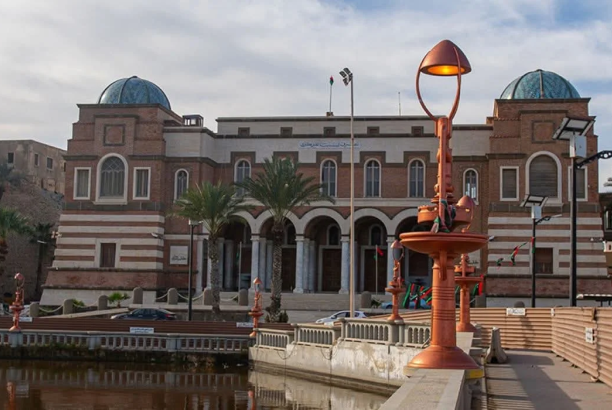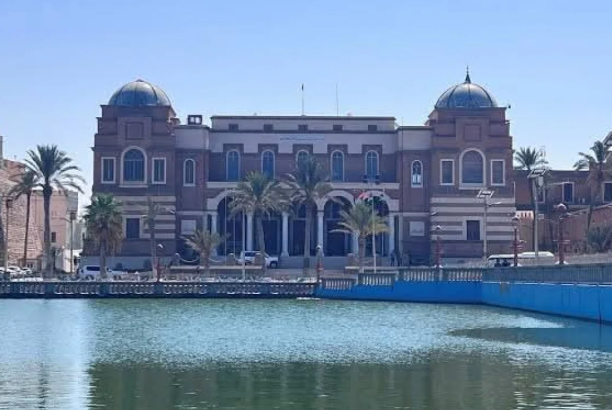Economist Mohamed Al-Safi said in a statement to our source: Imagine if we had a helicopter capable of flying over the country and dropping dinars to citizens, to spend whenever oil revenues in dollars drop (or are depleted)… Imagine also that these dinars were obtained without selling any goods or providing any service, simply “for free,” meaning that the helicopter owner has a printer to print dinars and doesn’t deserve anything but pressing the print button to produce the money… Wouldn’t that mean all our financial problems are solved, and we would achieve prosperity and development?
He added: Hold on, don’t rush to that conclusion. In this article, I will argue that helicopter money – despite the appealing idea at first and its use in other countries – has a significant negative impact on the economy in the Libyan context.
What is Helicopter Money? (Free Money)
The famous economist Milton Friedman used the example of helicopter money in one of his research papers to explain the effect of creating money without any backing on the economy… Friedman compared central banks to helicopters, since central banks are the only institutions in the country that can create new money out of thin air… But what does that mean in practice?
Central banks around the world can create new money in the economy by electronically or digitally printing money in the form of credits (not necessarily paper money)… This means that the central bank can print as much money as it desires if it chooses to do so… However, inflation is the main deterrent to printing money, whether by avoiding it in cautious cases or regulating it in calculated cases.
Early forms of monetary financing can be traced back to ancient civilizations where rulers would “devalue” coins. This included reducing the precious metal content in coins, effectively creating more money to finance their expenses.
He further said: The use of helicopter money became widespread during the Great Depression and World War II… However, the struggle in the 1970s to contain inflation, and many economic crises where monetary policy became a hostage to financial policies, made helicopter money taboo in economics, especially with the success of central banks in reducing inflation and the emergence of the principle of central bank independence from financial authorities. Thus, the idea of helicopter money became considered a serious threat to central bank independence.
However, the 2008 financial crisis and the COVID-19 crisis led some countries, particularly rich ones (like the United States and the United Kingdom), to resort to helicopter money to stimulate the economy due to the recession, reviving this policy once again.
I will use some of the terms that economists in Libya use to talk about helicopter money: deficit financing, electronic money printing, digital money printing, credit injection to finance the government, domestic public debt, and monetary financing… All these terms mean the same thing: creating new money in the economy without backing (free money).
Paper and Digital Money Printing (A Huge Difference)
One of the most important economic indicators is the money supply, which refers to the amount of money in the economy, composed of two components: the first is the balances in banks (digital money and cash in banks), and the second is the currency with the public (paper money outside of banks). This dual structure of money supply is important for understanding how the central bank prints money.
He continued: When the central bank prints paper money (cash), it prints it against reserves, meaning it doesn’t increase the money supply but changes its structure… The amount of paper currency increases at the same rate that digital money decreases in the bank reserves (when cash is withdrawn from the banks)… Since the money supply does not increase, this printing does not impact inflation unless the printing is counterfeit and not authorized by the central bank. But when digital money (helicopter money) is created, the money supply increases because the increase in digital balances is not offset by a decrease in paper currency.
He added: Therefore, creating electronic money increases the money supply, which contributes to inflation, while paper money printing affects the composition of the money supply without increasing it, meaning it does not impact inflation.
How Helicopter Money Affects Inflation (A Little Increase, A Big Jump)
Helicopter money has profound effects on both inflation rates and the value of the national currency. When the central bank injects large amounts of money into the economy, the money supply increases significantly. This increase in the money supply leads to a higher total demand for goods and services, as consumers have more purchasing power. If the supply does not keep up with this increased demand, prices will rise, leading to inflation. In extreme cases, this can lead to hyperinflation, where prices rise rapidly, weakening the purchasing power of the currency and creating an economic uncertainty.
Additionally, an increase in the money supply negatively impacts the currency’s value. As the supply of the national currency increases, its relative value decreases compared to other currencies. This decrease in the currency’s value makes imports more expensive, which increases inflationary pressures. It may also reduce the currency’s attractiveness to foreign investors, leading to capital outflows and instability in foreign exchange markets. Therefore, the use of helicopter money carries significant risks, as it can destabilize the economy by causing high inflation and devaluing the currency.
Economic Debate on Helicopter Money (Its Effects Depend on the Reason for Its Use)
Countries that use helicopter money can be divided into two main groups: the first group includes countries with effective monetary tools that suffer from economic stagnation, while the second group consists of countries lacking necessary monetary tools and facing budget deficits.
For the first group, these countries can create money conservatively under specific conditions, the first being that the primary motive for using this policy is to stimulate the economy during recessions, and creating inflation is a goal in itself, especially when interest rates are close to zero, limiting the effectiveness of further cuts to stimulate economic activity. In this case, money can be created temporarily as an “adrenaline” shot to boost the economy. Secondly, these countries have effective monetary tools to control inflation after stimulating the economy, for example, by gradually raising interest rates to control inflation resulting from the printing policy within acceptable limits, with the goal of maintaining an inflation rate of about 2%. Examples of these countries include the United States and the United Kingdom during the COVID-19 crisis when interest rates were close to zero while there was a critical need to stimulate the economy.
As for the second group, these countries typically have central banks that are not independent enough, with financial authorities exerting significant pressure on the central bank to finance budget deficits. These countries lack the freedom to manage money supply effectively, either due to the absence or ineffectiveness of interest rates or because of a fixed exchange rate system. These countries resort to using helicopter money primarily to finance government deficits, creating an “addiction” to this free money, reducing incentives to increase or maintain revenues. When inflation rises, the central bank finds it difficult to control it due to the lack of effective monetary tools. Examples of these countries include Zimbabwe, Iraq, Egypt, Argentina, and unfortunately, Libya.
He also explained: Friedman argued that a permanent increase in money through helicopter money could stimulate economic activity, because when digital money is printed and distributed in the economy (either by financing governments or giving it directly to individuals), people will use this money to demand goods and services, thus boosting economic activities in the short term. However, this policy doesn’t come without consequences, as overuse of this monetary policy and creating a quantity of money greater than the market’s ability to absorb or spend in productive channels leads to inflation in the medium and long term… Also, this new money is typically used to finance budget deficits, making the central bank a hostage to government spending (Libya is a prime example, where the central bank has fallen into the trap of financing the government and has not found a way out yet).
Libyan Helicopter Money Packages:
Unfortunately, due to the lack of reports and data, it is impossible to pinpoint exactly when this policy was used in Libya, but public debt can be used as a proxy. Some experts estimate that helicopter money was used in Libya since the 1980s, especially after the drop in oil prices in 1981, when the Libyan state began to finance part (not all) of the budget deficit by creating new money without backing (other claims suggest that social security shares were used instead of helicopter money, but I couldn’t confirm this information due to the lack of data). However, what is certain is that there was an increase in inflation and the loss of the Libyan dinar’s value in the black market, resembling the symptoms of helicopter money. Public debt continued until the 1990s embargo, and the use of this policy stopped after 2000 due to the lifting of the embargo, the exchange rate adjustment above 1 dinar in 2003, and the central bank’s independence from the Ministry of Finance (see the graph below for the growing public debt in Libya).
He also said: However, after the oil closures that began in 2013, the division of governments, and the split of the central bank after 2014, this policy was revived. The central banks in Benghazi and Tripoli resorted to helicopter money to finance the various governments, resulting in a significant increase in the money supply. The central bank in Benghazi printed over 70 billion dinars, while the central bank in Tripoli printed over 80 billion dinars, exacerbating the money supply in Libya between 2011 and now (the same graph shows the jump in public debt compared to previous stages when helicopter money was used).
Why Helicopter Money is an Economic Bomb in Libya (Gas Poured on the Fire of Inflation)
After the “unification” of the central bank and the change in the exchange rate, it was assumed that the helicopter money policy would stop. However, with the inflation of consumer spending, the need for developmental spending on reconstruction, suspicions of corruption in the oil sector and barter operations, and a lack of oil revenues in dollars, helicopter money has resurfaced. Some forecasts indicate printing 70 billion new dinars
to compensate for the drop in oil revenues due to the dollar drop. This means that inflation will increase to unprecedented rates, as it did between 2013 and 2015. Helicopter money will further weaken the currency value and increase Libyan citizens’ suffering, especially those who rely on the dinar’s purchasing power for basic needs. This step is, at best, a temporary solution to avoid crises but, in the long run, it’s a way to cover the cracks in the economic model. It won’t benefit Libyan citizens because, as is evident in countries that used helicopter money, inflation and currency devaluation are inevitable.
Conclusion:
The Libyan economy needs more sustainable solutions, like diversification, productive investments, and institutional reforms. Helicopter money is a temporary, illusory escape from current challenges.






